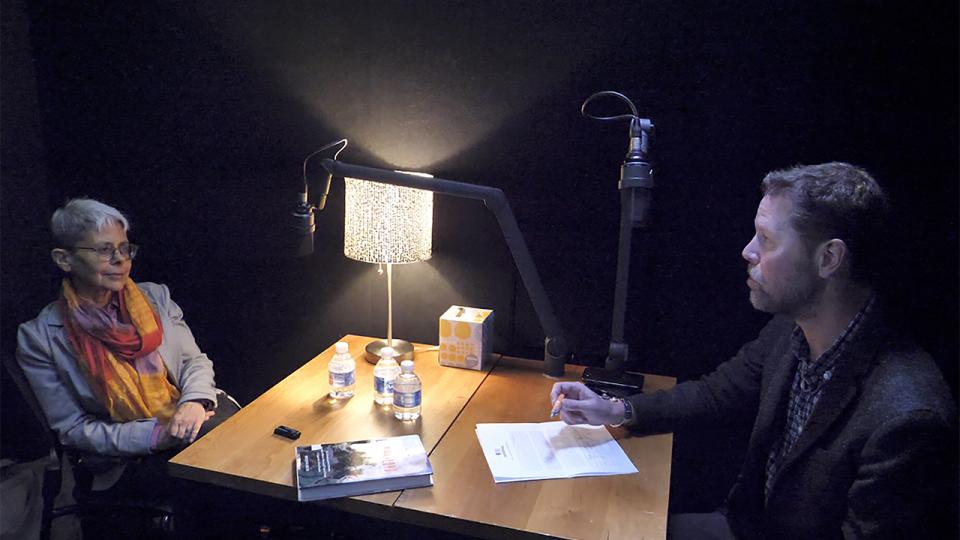Make a donation to the museum
Stories of Hope: Safekeeping Memories
Stories of Hope: Safekeeping Memories

As an oral historian and curator at the 9/11 Memorial Museum, people always want to know which of the oral histories I’ve conducted are my favorites, which are the best. To me, those are impossible questions to answer, not because some don’t stand out, not because the Museum’s collection numbers more than 2,500 oral history and StoryCorps recordings, but because it has been an honor and responsibility to conduct so many of them.
I could tell you about the afternoon I spent at the home of Rosalie Downey, who along with her children and grandchildren shared their memories of her husband, New York City Fire Department Chief Ray Downey, pointing out various helmets he had worn throughout his long and distinguished career and the many proclamations, quilts, and other condolence gifts the family received from people around the country after his death on 9/11. One of his daughters told me how he had uncharacteristically called home while responding to the terrorist bombing in Oklahoma City, grappling with the deaths of so many children there.
I could tell you about Port Authority Police Officer Will Jimeno, who described realizing that he was suffering from PTSD after being trapped deep within the wreckage of the World Trade Center for hours, or New York City Police Officer Scott Strauss, who silently apologized to his wife and children for crawling into that burning wreckage to reach Will, knowing that he might not make it out alive.
I doubt I’ll ever find the words to tell you how I felt when Marriott Hotel survivor Frank Razzano told me what swirled through his heart and mind about his parents, his daughter, the life he had lived, as he endured the collapse of first one then the other Twin Tower, and the struggle with survivor guilt that followed until he made a pilgrimage to Santiago De Compostela some years later.
It would be a little easier to tell you about spending two days at the Working Dog Center at the University of Pennsylvania Veterinary School, recording with veterinarians who had responded to the Pentagon and the World Trade Center site to care for the dogs searching for survivors and those who had died there.
Back in 2006, when I learned that it would be our goal to record a remembrance for each person killed on 9/11 and in the 1993 bombing of the World Trade Center, I had no real understanding of what it would take to accomplish that goal, even if we could get there, or how it would affect me and how I looked at the world. The bitter sweet conversations I had in the StoryCorps recording booth with Gordon and Kathy Haberman, whose 25-year-old daughter Andrea died in the North Tower on her first ever trip to New York from the Midwest, and with Jack and Evelyn Zelmanowitz, the brother and sister-in-law of Abe Zelmanowitz, who died in the South Tower at the side of his colleague and friend Ed Beyea, stay with me today, more than a decade after we recorded. Evelyn called me in October to tell me that Jack had recently died and said that she too recalled our time in the recording booth together.
In February, just as we were beginning to hear about the COVID-19 pandemic, I recorded one last in-person oral history that epitomizes what I do and why I do it. About 10 years earlier, Mike Brown, an emergency medical doctor, had finished writing a book titled What Brothers Do, about his childhood in Queens with his older brother Pat, following in Pat’s footsteps to join the FDNY before medical school, and his search for Pat at Ground Zero. At the 9/11 Memorial Museum, we knew Pat as the Captain of Ladder 3, the firetruck you see in the Museum. I wanted to know about Pat through Mike’s eyes, and to record Mike’s own story about the months that followed 9/11, so I went to a book signing not far from the firehouse and began a multi-year campaign to encourage Mike to record with me. We finally sat down together, along with three of Pat’s friends who had become a support system for Mike as he dealt with the cancer he developed as a result of his time at Ground Zero. Highly unorthodox in the world of oral history but the right thing for Mike Brown. One of those friends emailed me in November 11, on what would have been Pat’s 68th birthday, to say that Mike had succumbed to his illness a few weeks earlier. Waiting for Mike to feel ready to record took some patience, but waiting gave him the time and space he needed to reflect deeply on his relationship with his brother and with Pat’s fire department brothers and how 9/11 had shaped nearly the last 20 years of his life.
If I had unlimited time, I would tell you about the memories shared with me about Sandra Conaty Brace and John Napolitano and so many others. Instead, I will quote from a prayer of remembrance that seems appropriate to the oral histories in the collection of the 9/11 Museum:
In the blueness of the sky and in the warmth of summer,
we remember them.
By Amy Weinstein, Senior Curator of Oral History & Vice President of Collections, 9/11 Memorial & Museum
Previous Post
Announcing the Winter/Spring 2021 Public Programming Season

The 9/11 Memorial & Museum’s Winter/Spring 2021 public program season will kick off on Monday, February 8, and will cover a range of topics that address the ongoing impacts and continued resonance of the 9/11 and 1993 attacks, their historical context, and their aftermath.
Next Post
Upcoming Public Program: "The Rise of Global Jihad"

We are pleased to present the next program in our When the World Changes digital conversation series at 2 p.m. ET on Monday, February 8.